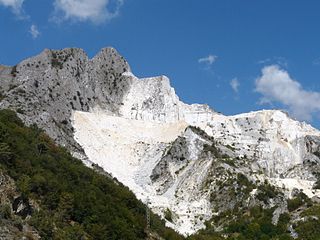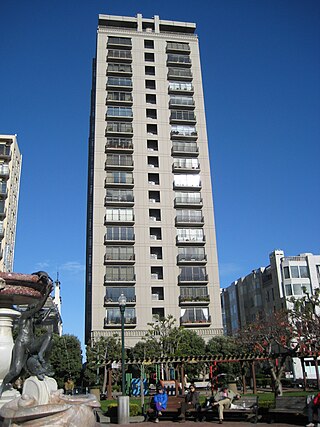Related Research Articles

Mining is the extraction of valuable geological materials from the Earth and other astronomical objects. Mining is required to obtain most materials that cannot be grown through agricultural processes, or feasibly created artificially in a laboratory or factory. Ores recovered by mining include metals, coal, oil shale, gemstones, limestone, chalk, dimension stone, rock salt, potash, gravel, and clay. Mining in a wider sense includes extraction of any non-renewable resource such as petroleum, natural gas, or even water.
Escheat is a common law doctrine that transfers the real property of a person who has died without heirs to the crown or state. It serves to ensure that property is not left in "limbo" without recognized ownership. It originally applied to a number of situations where a legal interest in land was destroyed by operation of law, so that the ownership of the land reverted to the immediately superior feudal lord.

A quarry is a type of open-pit mine in which dimension stone, rock, construction aggregate, riprap, sand, gravel, or slate is excavated from the ground. The operation of quarries is regulated in some jurisdictions to reduce their environmental impact.

Open-pit mining, also known as open-cast or open-cut mining and in larger contexts mega-mining, is a surface mining technique of extracting rock or minerals from the earth from an open-air pit, sometimes known as a borrow.
In common law and statutory law, a life estate is the ownership of immovable property for the duration of a person's life. In legal terms, it is an estate in real property that ends at death when ownership of the property may revert to the original owner, or it may pass to another person. The owner of a life estate is called a "life tenant".

Land rehabilitation as a part of environmental remediation is the process of returning the land in a given area to some degree of its former state, after some process has resulted in its damage. Many projects and developments will result in the land becoming degraded, for example mining, farming and forestry.
The Inclosure Acts, which use an archaic spelling of the word now usually spelt "enclosure", cover enclosure of open fields and common land in England and Wales, creating legal property rights to land previously held in common. Between 1604 and 1914, over 5,200 individual enclosure acts were passed, affecting 28,000 km2.
A leasehold estate is an ownership of a temporary right to hold land or property in which a lessee or a tenant holds rights of real property by some form of title from a lessor or landlord. Although a tenant does hold rights to real property, a leasehold estate is typically considered personal property.

In common law systems, land tenure, from the French verb "tenir" means "to hold", is the legal regime in which land owned by an individual is possessed by someone else who is said to "hold" the land, based on an agreement between both individuals. It determines who can use land, for how long and under what conditions. Tenure may be based both on official laws and policies, and on informal local customs. In other words, land tenure implies a system according to which land is held by an individual or the actual tiller of the land but this person does not have legal ownership. It determines the holder's rights and responsibilities in connection with their holding. The sovereign monarch, known in England as The Crown, held land in its own right. All land holders are either its tenants or sub-tenants. Tenure signifies a legal relationship between tenant and lord, arranging the duties and rights of tenant and lord in relationship to the land. Over history, many different forms of land tenure, i.e., ways of holding land, have been established.

In feudal Anglo-Norman England and Ireland, a knight's fee was a unit measure of land deemed sufficient to support a knight. Of necessity, it would not only provide sustenance for himself, his family, and servants, but also the means to furnish himself and his retinue with horses and armour to fight for his overlord in battle. It was effectively the size of a fee sufficient to support one knight in the ongoing performance of his feudal duties (knight-service). A knight's fee cannot be stated as a standard number of acres as the required acreage to produce a given crop or revenue would vary depending on many factors, including its location, the richness of its soil and the local climate, as well as the presence of other exploitable resources such as fish-weirs, quarries of rock or mines of minerals. If a knight's fee is deemed co-terminous with a manor, an average size would be between 1,000 and 5,000 acres, of which much in early times was still "waste", forest and uncultivated moorland.
Waste is a term used in property law to describe a cause of action that can be brought in court to address a change in condition of real property brought about by a current tenant that damages or destroys the value of that property. A lawsuit for waste can be brought against a life tenant or lessee of a leasehold estate, either by a current landlord or by the owner of a vested future interest. The holder of an executory interest, however, has no standing to enforce an action for waste, since his future interest is not vested. There are several different kinds of waste under the law.
In property law of the United Kingdom and the United States and other common law countries, a remainder is a future interest given to a person that is capable of becoming possessory upon the natural end of a prior estate created by the same instrument. Thus, the prior estate must be one that is capable of ending naturally, for example upon the expiration of a term of years or the death of a life tenant. A future interest following a fee simple absolute cannot be a remainder because of the preceding infinite duration.
The Settled Land Acts were a series of English land law enactments concerning the limits of creating a settlement, a conveyancing device used by a property owner who wants to ensure that provision of future generations of his family.

Quarry Lakes Regional Recreation Area is a regional park located in Fremont, California that is part of the East Bay Regional Parks system. Before being converted into a park, the site was used as a gravel quarry. When water purchased by the public for groundwater recharge of the Niles Cone flooded the gravel pits, the gravel harvesters began to daily pump the seeping water down Alameda Creek into San Francisco Bay. The Alameda County Water District acquired the quarry after the pumping was declared to be an illegal waste in 1976.
The history of English land law can be traced back to Roman times. Throughout the Early Middle Ages, where England came under rule of post-Roman chieftains and Saxon monarchs, land was the dominant source of personal wealth. English land law transformed further from the Saxon days, particularly during the post-Norman Invasion feudal encastellation and the Industrial Revolution. As the political power of the landed aristocracy diminished and modern legislation increasingly made land a social form of wealth, subject to extensive social regulation such as for housing, national parks, and agriculture.
Dominium means "dominion; control; ownership". It is used in some phrases and maxims in legal Latin:

Landlord–tenant law is the field of law that deals with the rights and duties of landlords and tenants.
The Rule in Shelley's Case is a rule of law that may apply to certain future interests in real property and trusts created in common law jurisdictions. It was applied as early as 1366 in The Provost of Beverly's Case but in its present form is derived from Shelley's Case (1581), in which counsel stated the rule as follows:
…when the ancestor by any gift or conveyance takes an estate of freehold, and in the same gift or conveyance an estate is limited either mediately or immediately to his heirs in fee simple or in fee tail; that always in such cases, 'the heirs' are words of limitation of the estate, not words of purchase.

In English common law, real property, real estate, immovable property or, solely in the US and Canada, realty, is land which is the property of some person and all structures integrated with or affixed to the land, including crops, buildings, machinery, wells, dams, ponds, mines, canals, and roads, among other things. The term is historic, arising from the now-discontinued form of action, which distinguished between real property disputes and personal property disputes. Personal property, or personalty, was, and continues to be, all property that is not real property.
As a legal document, the broad form deed severs a property into surface and mineral rights. This allows other individuals or organizations other than the land owners to purchase rights to resources below the surface. These parties also receive use of surface resources — such as wood or water — to facilitate gathering the resources below ground. Based on English legal theory but an American creation from the early 1900s, the broad form deed was used by land and coal companies in many states within the Appalachian Region.